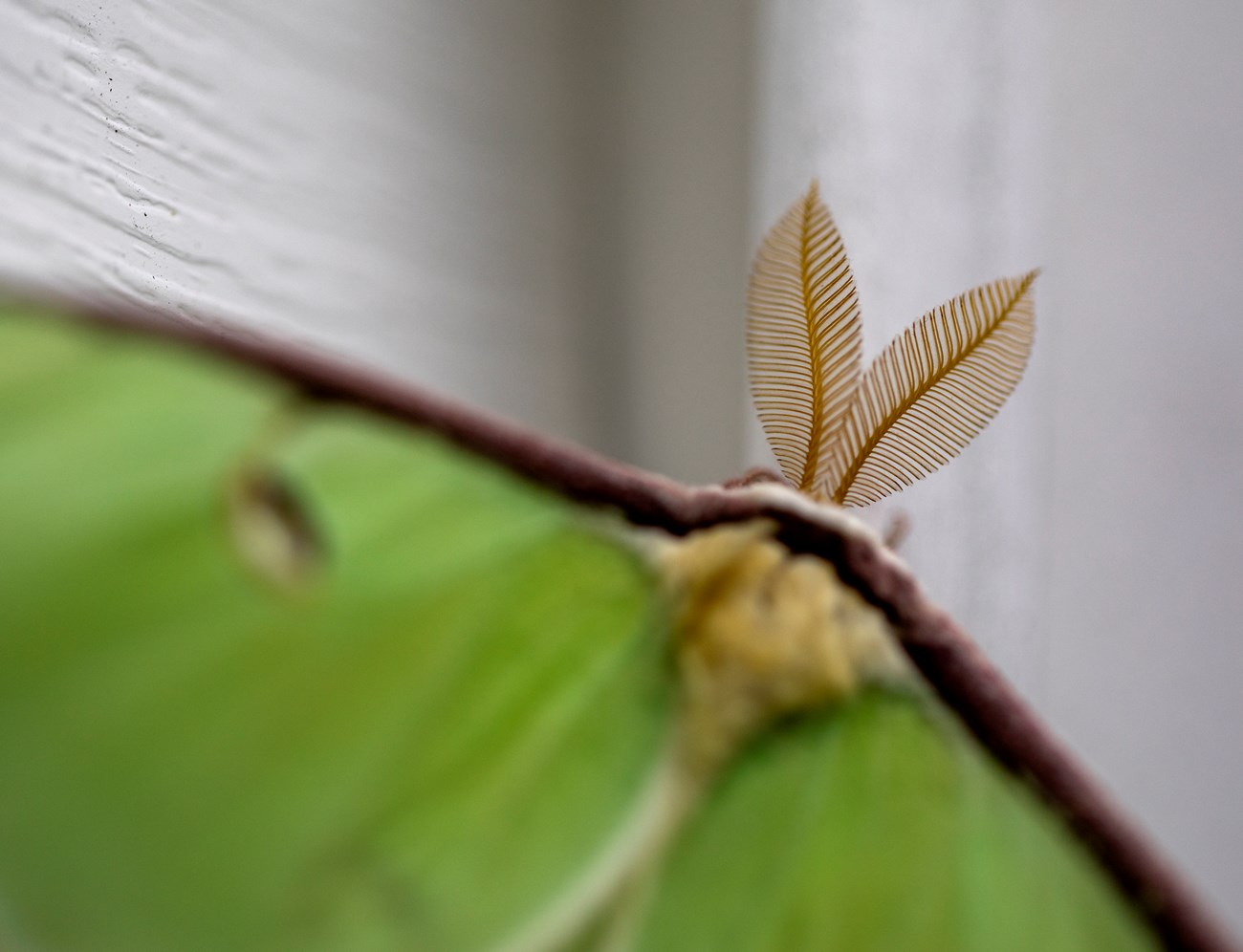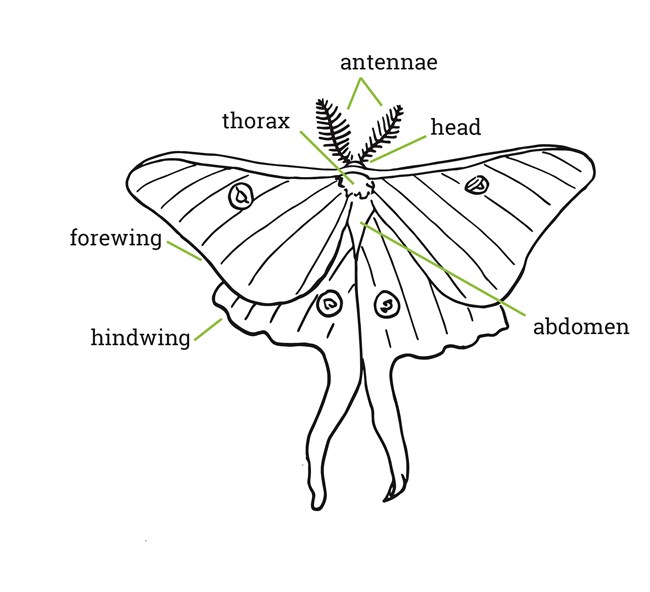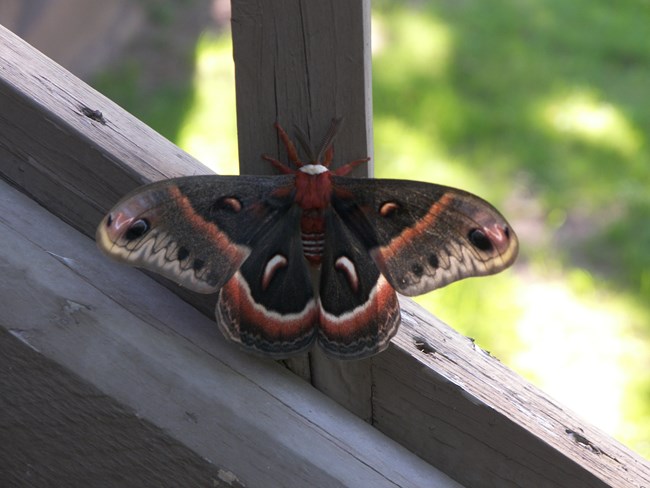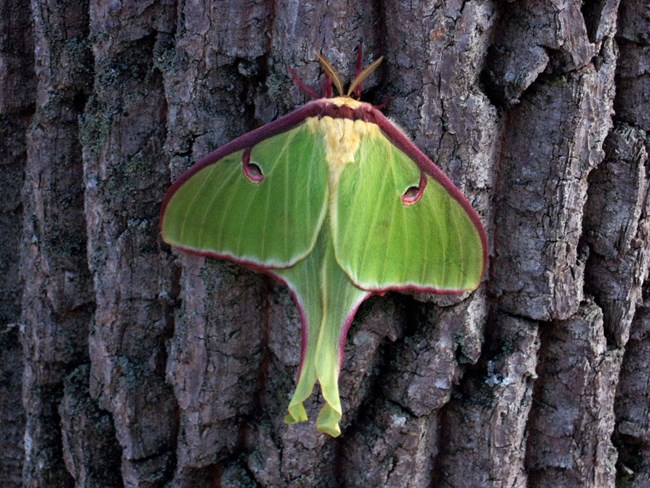Last updated: October 29, 2020
Article
Moths of Acadia

Photo by Will Newton, Friends of Acadia, NPS
Moths of Acadia
Do you know the difference between a moth and a butterfly? One Summit Steward asked park visitors this exact question.Some said, “moths are ugly,” others said, “moths eat your clothes.” Some knew about the destructive habits of invasive moths like the Gypsy Moth or Brown Tail Moth, whose presence has grown in the park over the last couple of years. Unlike their beautifully colored relatives, the butterfly, moths have a bad reputation. Let’s take some time to learn about and appreciate these fascinating and important insects.

Drawing courtesy of Chiara Jeanfils, Friends of Acadia, NPS
Difference Between Moths and Butterflies
Compared to butterflies, moths tend to have thicker, furrier bodies, with “feather-like” antennae that have lateral filaments called pectinations. These textured antennae give moths a great sense of smell, allowing males to find females from miles away. Moths are generally nocturnal, which means most active at night, compared to their cousins the butterfly which are primarily diurnal, meaning most active during the day. Due to their nocturnal nature, moths tend to have duller colored wings and are experts of camouflage. When resting, moths tend to hold their wings parallel to their body and cover their abdomen.
Butterflies, on the other hand, tend to fold their wings vertically over their back. Unlike butterflies, moths create a silk covering called a cocoon for protection during their pupating stage, not a chrysalis, which is smooth and hard.
Importance within Acadia's Ecosystems
Moths make up over 90 percent of the Lepidoptera order, a grouping that classifies both butterflies and moths. In the United States alone, there are over 11,000 species of moths. During the 2016 Bioblitz conducted in Acadia, over 180 moth species were found in just 48 hours. This abundance makes them a crucial part of the ecosystem and key players at the bottom of the food chain. They are an important food source for a variety of species including other insects, frogs, toads, birds, and especially bats.
Acadia harbors species like the federally threatened northern long-eared bat and the state-endangered little brown bat. It is vital that moth populations stay sustainable since moths make up a hefty portion of bat meals. Additionally, moths are wonderful pollinators since their hairy bodies allow them to easily pick up pollen and move it from flower to flower. In Acadia, the commonly found bush honeysuckle is pollinated by moths, and generally, if a flower is white and smelly, there’s a good chance it’s moth pollinated.

NPS Photo
Giant Moths
It's a bird, it's a plane, it's a...giant moth? In Acadia, there are several moths from the Saturniidae family, which includes the giant silk moths and royal moths. The Luna moth, Cecropia moth, and Polyphemus moth are all giant silk moths. Interestingly, the adults of these species only live a couple of days to reproduce and lay eggs. Since there’s no time to waste on eating during this period, the adults have evolved without mouths. The fan-favorite Luna moth has long “tails” on its hindwings and a vivid green coloration.
Cecropia moths are the largest moths in North America with a wingspan of up to 7 inches and identified by a pronounced red band on their hindwing. The Polyphemus moth is an orange-brown color with large distinct “eye-spots”, known to scare away predatory birds, on its hindwings. The rosy maple moth is a royal moth and distinguishable by its fluffy yellow body and pink wings.

NPS Photo
Observing Moths
If you are camping in Acadia or hiking at night be on the lookout for moths. Their impressive camouflage skills might sometimes make them difficult to spot, but with a flashlight and some practice, you’ll begin to notice how many different species are hiding in plain sight. If you’re lucky, you might even encounter one of the showy giant silk moths. When observing moths, it is always best to take pictures instead of handling them. Their wings have millions of little “scales” than can easily rub off with handling and hurt their ability to fly. Don’t forget to thank them for the important ecosystem services they provide.
References
Butterfly Conservation (n.d.) Importance of Moths. Retrieved from: http://www.mothscount.org/text/16/importance_of_moths.html
iNaturalist (n.d.) Observations of Emperor, Royal, Moon, and Giant Silk Moths on Mount Desert Island. Retrieved from: www.inaturalist.org/observations?nelat=44.38557&nelng=-68.191777&place_id=any&swlat=44.2777529&swlng=-68.471895&taxon_id=47918
Nature North (n.d.) A Guide to the Giant Silk Moths of Manitoba. Retrieved from: www.naturenorth.com/spring/bug/silkmoth/guide.html
Department of Systematic Biology, Entomology Section, National Museum of Natural History and Public Inquiry Services, Smithsonian Institution (n.d.) Retrived from: www.si.edu/spotlight/buginfo/moths
Library of Congress (n.d.) "How can you tell the difference between a butterfly and a moth?" Retrieved from: https://www.loc.gov/everyday-mysteries/zoology/item/how-can-you-tell-the-difference-between-a-butterfly-and-a-moth/
Chandler, D., Manski, D., Donahue, C., & Alyokhin, A. (2012). TB206: Biodiversity of the Schoodic Peninsula: Results of the Insect and Arachnid Bioblitzes at the Schoodic District of Acadia National Park, Maine. Retrived from: https://pdfs.semanticscholar.org/fc0a/ba01735cbef0f020a3882d7dd5d0da2748bf.pdf
